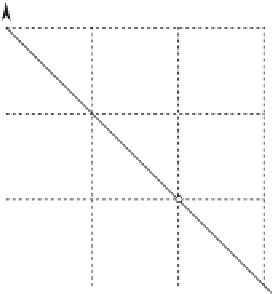Graphics Reference
In-Depth Information
t
=
the position vector for T, and
=
p
the position vector for any point P xy on the line.
Then
p
=
t
+
v
ˆ
(3.1)
It should be obvious that Eq. (3.1) works equally well in R
3
as it does in R
2
, so let us bring it
alive using the coordinates used in Fig. 3.1.
Y
T
λ
v
ˆ
t
P
p
O
X
Figure 3.1.
We see that
t
points to T 12
and
v
=
i
−
j
Therefore,
ˆ
=
1
√
2
i
−
v
j
When
=
0
x
=
1 and y
=
2
and when
=
1
1
√
2
x
=
1
+
=
17071
1
√
2
y
=
2
−
=
12929
Thus, 17071293 is a point one unit along
v
from T. By changing the value and sign of ,
ˆ
we can move forward or backward along
v
.
ˆ













